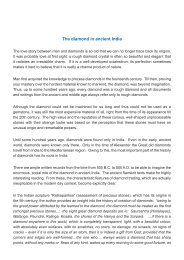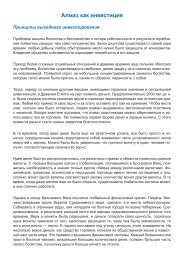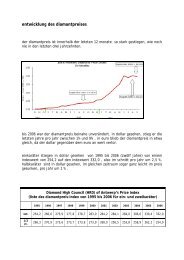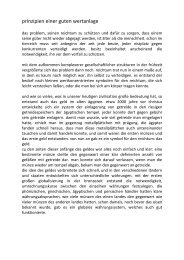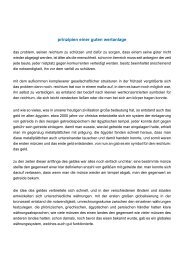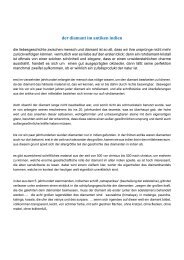A diamond is born - Diamantschleiferei Michael Bonke
A diamond is born - Diamantschleiferei Michael Bonke
A diamond is born - Diamantschleiferei Michael Bonke
- No tags were found...
You also want an ePaper? Increase the reach of your titles
YUMPU automatically turns print PDFs into web optimized ePapers that Google loves.
The next work step <strong>is</strong> designing. Th<strong>is</strong> task <strong>is</strong> very important and full of responsibility. The resultof the cutting and pol<strong>is</strong>hing <strong>is</strong> largely dependent on th<strong>is</strong> one small step. While designing, thesuperv<strong>is</strong>or meticulously observes the <strong>diamond</strong> under a magnifying glass. Then he/she decideswhere the sawing cut can be made. A lot depends on the correct selection of the plane to be cut.It may happen that the cut has to go through an inclusion, which can then be cut away duringthe cutting and pol<strong>is</strong>hing process. Furthermore, the sawing cut must be such that after sawing,both halves must correspond to the ideal proportions of the brilliant to be pol<strong>is</strong>hed. Another veryimportant dec<strong>is</strong>ion <strong>is</strong>, whether a large and a small stone should be cut out of the rough <strong>diamond</strong> orwhether there should be two brilliants of the same size. Th<strong>is</strong> <strong>is</strong> usually a mathematical dec<strong>is</strong>ion.Example:a 5.0 ct rough <strong>diamond</strong> <strong>is</strong> to be sawed. If it <strong>is</strong> cut in the middle, we will get two raw brilliants ofalmost the same size, i.e. of 2.45 ct each with a yield of 42%; th<strong>is</strong> will result in two <strong>diamond</strong>sof 1.03 ct each. If the saw-cut <strong>is</strong> asymmetrical, then we would get one rough <strong>diamond</strong> of 3.0ct and one of 1.95 ct. These two cut brilliants would then have a weight of 1.26 ct and 0.82 ctrespectively. The sales returns of these two stones would be much lower than two stones of onewhole carat each.Another example:a rough <strong>diamond</strong> of 4 ct <strong>is</strong> sawed. If cut in the middle, it will result in two raw stones of 1.98 ct each,i.e. two brilliants of approximately 0.83 ct each. If the cut <strong>is</strong> asymmetrical, we will get a 2.5 ct stoneand a 1.46 ct stone. These two stones will yield two brilliants of 1.05 ct and 0.61 ct respectively.In th<strong>is</strong> case, the asymmetrical sawing cut <strong>is</strong> more advantageous, because one <strong>diamond</strong> of onewhole carat (1.05 ct) and the other of a good half carat (0.61 ct) are worth much more than two<strong>diamond</strong>s of good three-fourths of a carat (2 x 0.83 ct). So, such stones are cut asymmetrically.Even in case of very small stones, which yield only 0.01 ct after being cut and are barely the sizeof a pinhead, the designing must be done with great care. A careless designer can often cost thepol<strong>is</strong>hing plant the entire profit for that stone.



